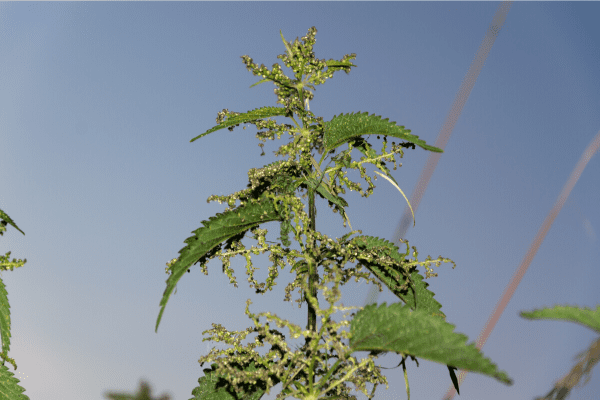“Leaves of three, let them be.”
Four Poisonous Plants Every Mom Should Know
Poison Ivy
- Poison Ivy ALWAYS has leaves of three, never more.
- Poison Ivy always grows left and then right from the base of the stem.
- It never has thorns.
- It never has saw-toothed or scalloped edges.
- Young leaves are tiny and red; older leaves are green.
- When Poison Ivy doesn’t get enough water the leaves will yellow and droop.
- It is common to find Poison Ivy as a forest ground-cover, many times mixed in with ferns. Poison ivy can deal with both wet and dry locations.
- Remember that because it is an “ivy,” in many instances, Poison Ivy will climb. Watch out overhead as well as underfoot.
- This should be common sense, but please DO NOT eat the berries from poison ivy plants. They are very beneficial to animals as a food source, but are NOT good for human consumption.
Poison Sumac

Winged and Staghorn Sumac are one of my favorite features of fall in Minnesota. The leaves change a beautiful red, and they are one of the quickest and earliest splashes of autumn color. I can always tell that autumn has arrived. However, there are multiple varieties of sumac and one of them is poisonous. Poison sumac has the same properties as poison ivy so it can’t hurt to be on your guard. Because poison sumac is not as well-known as poison ivy, I don’t have as many resources for you. However, this gallery does a good job showing the leaves throughout the season with some closeup of what the bark, berries, and leaves look like.
Some identifying features are:
- Sumac has red stems.
- Sometimes (but not all the time), poison sumac has a little side leaf right near the end leaf (example above).
- There are several varieties of sumac. Poison sumac, however, does not have sawtoothed edges but instead have smooth edges.
- Sumac begins as a young sapling but can grow to the size of a medium-sized tree.
- Poison sumac likes to grow in wet environments.
- This isn’t always the case, but look around for a sparse shrub or tree. Oftentimes, poison sumac will grow into that and use it as a host.
- Poison sumac has a pinnate leaf structure, where each stem has two parallel rows of leaves growing along its length. Imagine a mirror going down the center of the stem. Each side of the stem has a matching leaf. Usually there will be six to twelve leaves on each stem with a single leaf at the very end of the stem.
- This is another that you have to watch out overhead for, as sumac trees can grow to be quite tall.
Wild Parsnip
Wild Parsnip is a member of the carrot family, but unlike it’s cousin, this guy is just bad news for you and your kiddos. It’s classified as an invasive species by the DNR. The skin reaction for wild parsnip is different than that of poison ivy, oak, and sumac. With poison ivy and sumac, the ursodiol in all parts of the plant will cause skin sensitivities and blisters upon reaction. With wild parsnip, however, the juice that is in it that will essentially cause localized sunburns when combined with the presence of sunlight. Blistering and rashes will occur. Once your eyes are opened to these plants, you’ll realize that they’re all over our beautiful state. Here is a little more extensive information about wild parsnip burn and how to treat it. Here’s a video that demonstrates how to identify wild parsnip.
Identifying features:
- Stem is deeply ridged.
- 5 to 15 leaflets.
- When plant flowers, it is a yellow-flat headed shape. The flowers have five small petals that are clustered in groups (called umbels) that are 4 to 8 inches in diameter.
- Leaves on the stem have sharp tooth-like edges.
- Wild Parsnip will often grow to about five feet high. It is most commonly found along highways, in poorly tended pastures, in areas that are only tended once or twice a year.
Stinging Nettles
Ugh. Stinging nettles. Don’t get me started. These guys are everywhere. In fact, my kids just got into some last weekend. Can’t a mom get a break, (especially when she’s writing a guide to poisonous plants?!) Now, if you just go ahead and Google “stinging nettle,” the results that you’re going to get are NOT what you want. Many people eat stinging nettles and other kinds of nettles for their nutritive and medicinal benefits. That’s not what we’re going for here, though. The burn and sting of a stinging nettle is truly not fun.
Stinging nettles’ “poisonous” parts are in the silky hairs that are on the leaves of this plant. These silky hairs contain chemicals like histamine and formic acid that are irritants to our skin. The reaction will develop within an hour after contact and can be mild to severe. Acute cases (one time) can be treated at home, but in some cases, it becomes a chronic reaction, where you’ll definitely need medical advice to get rid of it. Better safe than sorry, learn how to avoid these plants!
Identifying features:
- Stems are fairly rigid.
- All parts of the leaves and stems are covered with tiny hairs. The hairs are mostly going to be on the underside of the leaves and stem, but they cover the whole plant.
- Stems are four-sided, somewhat heart-shaped, finely toothed, with deep groves and tapering at the end to form the point of the “heart.”
- Leaves are opposite one another along stem. Look at the photo above. Do you see how each leaf has a partner across the center?
Plant Safety Tips
Here are some generally good recommendations from MN’s poison control system for things to teach your kids about plants and recommendations for if you think your kids have ingested or had exposure to a poisonous plant. Symptoms can take 24-48 hours or even up to a week to show up, particularly if its your first exposure! Of special note, it’s important to wash in cool or cold water instead of hot, because the hot will open your pores up and make the skin irritation worse.
If you have immediate concerns, the poison control center’s phone number is 1-800-222-1222, and experts are available 24 hours a day, seven days a week. Also, please seek medical attention if you are concerned about rashes, fevers, blisters on yourself or your child.
Rochester Mom wants you and your children to be safe! Always keep a mindful eye on your surroundings, but don’t let fear hamper you from spending time outdoors. The best antidote to fear is knowledge. While this post is informative, we always recommend seeking medical advice from your primary care provider.


